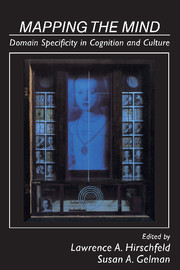Book contents
- Frontmatter
- Contents
- List of contributors
- Preface
- Part I Overview
- Part II The origins of domain knowledge: Biology and evolution
- 2 The modularity of thought and the epidemiology of representations
- 3 The organization of lexical knowledge in the brain: Evidence from category- and modality-specific deficits
- 4 Origins of domain specificity: The evolution of functional organization
- Part III The origins of domain knowledge: Conceptual approaches
- Part IV Are domains theories?
- Part V Domains across cultures and languages
- Part VI Implications for education
- Author index
- Subject index
3 - The organization of lexical knowledge in the brain: Evidence from category- and modality-specific deficits
Published online by Cambridge University Press: 04 August 2010
- Frontmatter
- Contents
- List of contributors
- Preface
- Part I Overview
- Part II The origins of domain knowledge: Biology and evolution
- 2 The modularity of thought and the epidemiology of representations
- 3 The organization of lexical knowledge in the brain: Evidence from category- and modality-specific deficits
- 4 Origins of domain specificity: The evolution of functional organization
- Part III The origins of domain knowledge: Conceptual approaches
- Part IV Are domains theories?
- Part V Domains across cultures and languages
- Part VI Implications for education
- Author index
- Subject index
Summary
How is lexical knowledge organized in the brain? Are semantic distinctions among, for example, animals, vegetables, furniture, and musical instruments or grammatical distinctions among nouns, verbs, and adjectives reflected in the organization of lexical knowledge in the brain? In this chapter we argue that evidence from the analysis of the performance of brain-damaged subjects provides the basis for far-reaching speculations, not only about the functional organization of lexical knowledge, but also about the relation between lexical knowledge and the brain. Specifically, we review evidence suggesting that distinctions among different aspects of lexical knowledge – for example, lexical form and semantic and grammatical categories – are most likely subserved by distinct neuroanatomical structures. The evidence takes the form of selective impairments affecting restricted domains of knowledge – semantic and grammatical categories. The fractionation of lexical knowledge seemingly along the boundaries of semantic and grammatical categories offers the intriguing possibility that the organization of lexical knowledge in the brain honors these categorical distinctions.
Category-specific deficits: Semantic categories
In several reports it has been documented that brain damage can cause selective impairments of specific semantic categories. The reports of category-specific deficits have included the selective impairment of abstract or concrete nouns (e.g., Warrington, 1975; 1981), proper names (e.g., McKenna & Warrington, 1980; Semenza & Zettin, 1988; Lucchelli & De Renzi, 1992), body parts (e.g., Dennis, 1976), and geographical names (McKenna & Warrington, 1978).
- Type
- Chapter
- Information
- Mapping the MindDomain Specificity in Cognition and Culture, pp. 68 - 84Publisher: Cambridge University PressPrint publication year: 1994
- 13
- Cited by



